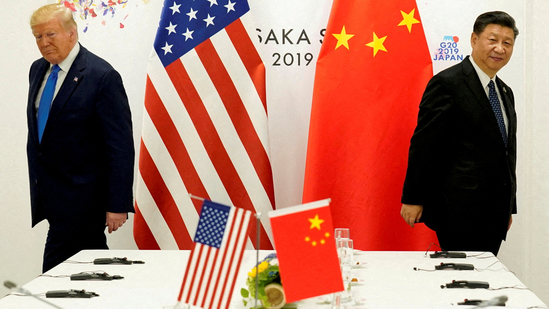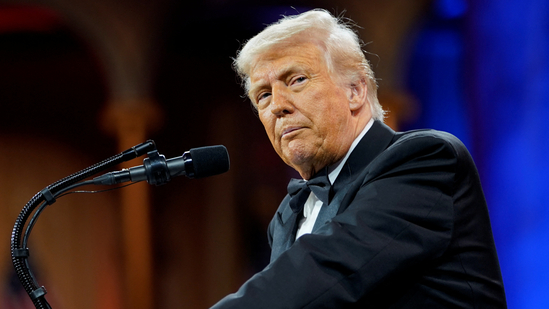Tariff war: Both China and the United States maintain the status of world’s largest economies yet they fight an economic battle using tariffs as tactical weapons. Since April 1 the United States has imposed increasing tariffs on Chinese exports which have now reached 104 percent while China matched these actions by elevating their boundaries on American goods between April 3 and today to an equivalent 151 percent.
The rest of the world feels deep concern about international stock market turbulence which destroyed trillions of dollars during that brief period. The continuous retaliation between China and the United States demonstrates signs that global economic recession is inevitable.
‘NO-LIMITS’ POKER DUEL
As the major economies address each other through blows both presidents continue their intense staring duel despite refusing to give in to the confrontation. US President Donald Trump aims to teach China about abusive tariff practices while Chinese President Xi Jinping declared his government will fight to the final consequence regarding the American “blackmail”.

The initial backward-and-forth US trade action against China has transformed into a boundless competitive battle between the nations. On April 2nd President Trump boosted US tariffs against China with his declaration of “Liberation Day” which prompted Beijing to counter with higher than previously applied duties thus triggering furious reaction from Trump.
The US President established an order where he required his Chinese counterpart to withdraw his actions within 24 hours. China’s leader Xi made the decision to stand firm against Trump with hopes of making him lose ground in this ‘bluff’ situation. Trump implemented an additional increase in the tariff levels despite his initial threats.
During his second reciprocity bout with Donald Trump Xi Jinping intensified his stance toward the high-stake tariff conflict which forced China to exceed US tariffs from 104 percent to 151 percent before waiting for Trump’s next move.
US’ 104% vs CHINA’S 151% – THE TARIFF MATH SO FAR
Trump and Xi have committed fully to this trade dispute by expanding their tariff programs to involve global economic security through an unsteady business future. A breakdown of current trade tariffs exists below:
- The tariff system in China had set US goods at 67 percent before April 2 but the United States had placed 10 percent duties on Chinese goods before the date. According to President Trump the Chinese trade policies stole “and ripped-off” US economic opportunities for many years.
The United States must have comparable trade policies to match those of China according to him. The resulting day became known as “Liberation Day” since it served to eliminate foreign punitive duty restrictions against US exporters and boost American wealth. (Till now China’s 67 per cent vs America’s 10 per cent).

2. President Donald Trump declared reciprocal trade tariffs against foreign entities that impose taxes on US products on April 2. The United States president labeled China as a nation that “abused” their tariff powers throughout numerous decades.
Trump articulated that “Reciprocity is at the heart of today’s tariffs because we implement exactly what other nations enforce upon us.” Right now the United States plans to levy tariffs which are still lower than what competitors charge according to Trump. Trump declared a 34 percent increase in tariffs against China after the latter maintained 67 percent tariffs at the time.
The current level of Chinese tariffs amounts to 67 percent while America’s combined imports and exports tariffs total 44 percent (11 percent plus 34 percent) (Till now China stood at 67 per cent vs America’s 10+34, equaling 44 per cent).
3. The White House declared on April 2 that United States’ administrations planned to impose a 10 percent non-tariff on imports from worldwide nations. This announcement came immediately after Trump officially declared his plan.
A national emergency created by security worries about continuous trade deficits will trigger the United States to establish a base level 10 percent duty for all countries according to a statement. The combined Chinese trade barrier rate had risen to 54 percent because of the added 10 percent. China maintained its existing rate of 67 percent which it applied against US imports during this time period.

4. Forty-eight hours after US raised retaliatory tariffs China implemented its countermeasures. Chinese officials announced to Beijing enterprises that Trump’s trade decisions would deliver major harm to their exports after which Xi Jinping implemented the same 34 percent increase as Trump’s plan to follow his threat about backing more negative consequences. The US now faced Chinese tariffs equaling 101 percent while China maintained its 54 percent rates against American exports.
5. Both April 7th and April 8th passed while the ongoing US-China trade war caused investor losses of trillions of market value worldwide. The two leaders refused to yield despite the situation. During a 24-hour deadline President Donald Trump demanded Xi Jinping to take down the Chinese retaliatory tariffs of 34 percent or he would implement a 50 percent tax on every Chinese product arriving from April 9.
The president made a 24-hour deadline to Xi who refused to give in thus prompting Trump to carry out his threat. The US imposed tariffs equal to 104 percent against China at this point yet Chinese tariffs against US exports reached 101 percent.
6. On April 9, 2025 Beijing took the stance of refusing to yield to American “blackmail” thus doubling down with another round of tariffs that matched Trump’s “additional 50 percent.” The increase in retaliatory tariffs by China reached 84 percent after the initial implementation of 34 percent. Current tariffs initiated by the US against China amount to 104 percent while the Chinese retaliatory tariffs consist of either ‘101+50′ or ’67+84’ units which renders a total of 151 percent.
Less than one week since its start the trade conflict between America and China remains intensifying and shows limited signs of reaching an end. The potential emergence of an economic downturn has been predicted by experts who observe negative impacts on stock markets together with oil prices and trade flows as well as supply chain operations and logistics activities.
US reacts to China’s 84% tariff tit-for-tat move: ‘Beijing should come to table’
The 84 percent trade tax imposed by China sparked an unfortunate reaction from US Treasury Secretary Scott Bessent who spoke to Fox Business Network.
According to Bessent China should abandon its attempt to decrease the value of their currency as a solution during this trade war and engage in negotiations.

According to Bessent China should focus on sanctioning people who send fentanyl precursor chemicals into the United States as this matter has been consistently emphasized by US President Donald Trump.
The US-China relations reached a critical point because President Trump criticized Beijing for its failure to curb fentanyl drug exports to America. Chinese officials believed President Trump employed the fentanyl issue to justify his trade tariffs while the foreign minister termed it “blackmail”.
Bessent as Treasury secretary in his statement indicated that foreign allies visiting America should examine ways to increase China’s balance in their relationships.
For more updates follow: Latest News on NEWZZY
